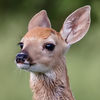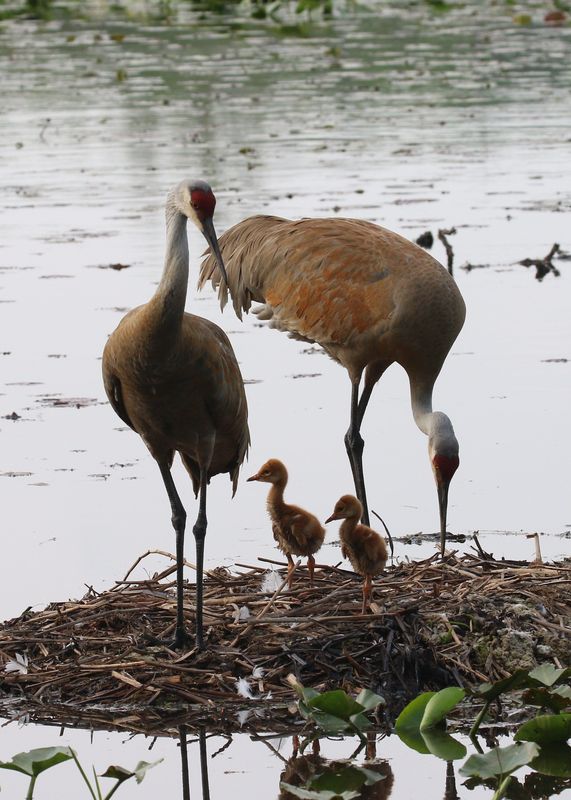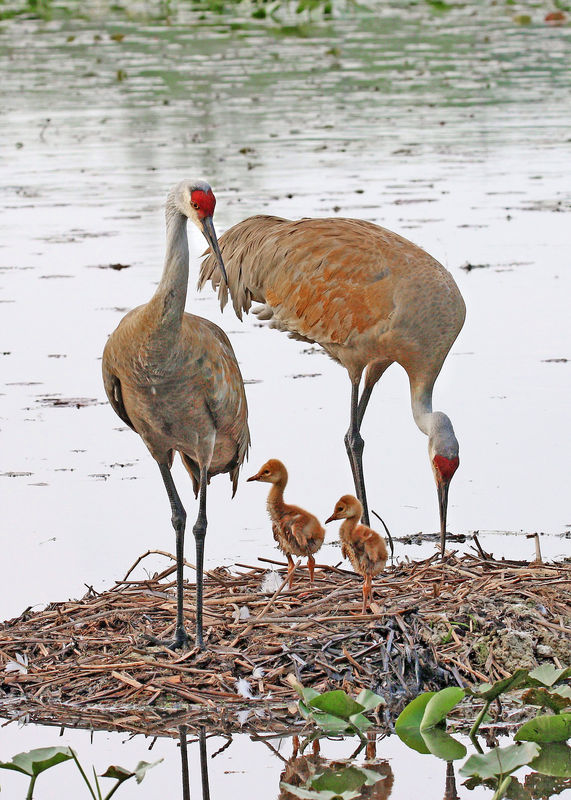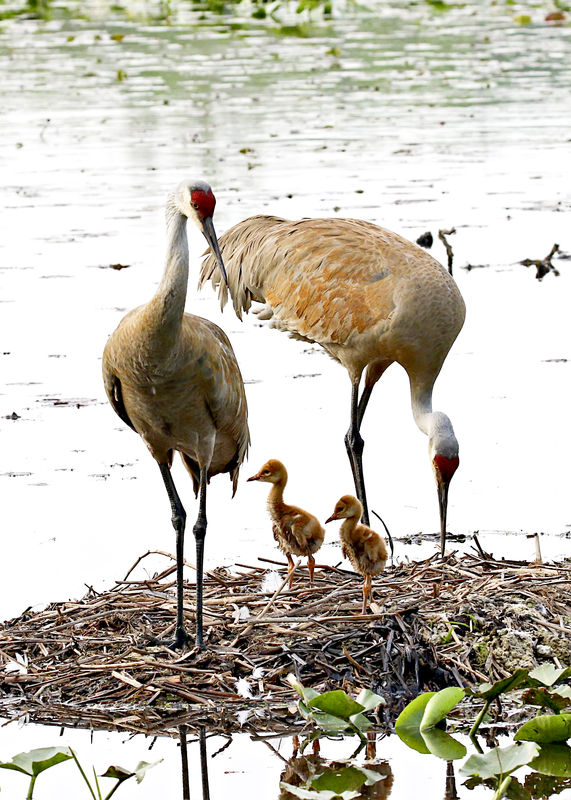Help with exposure
May 18, 2015 21:48:42 #
I uploaded the image below straight from raw; no exposure, color processing, etc., at all. The cranes are underexposed, the water behind them quite overexposed. How does one deal with such a lighting situation? Multiple different exposures is out; they are constantly moving.
Thx for ideas.
Thx for ideas.
May 18, 2015 21:54:35 #
Lightroom or PS or. Simply raise the shadows/Black, and lower the highlights. Crop a bit of excess from the top and your good to go.
the only way from the scene you can do that is spot meter the subject. The background will blow out, but frame your shot to minimize background. If the subject were a more cooperative one than birds or wildlife then you underexpose the picture and use flash to light the subject. For birds within 5-15 yards I use flash anyway for fill. At the longer distance I have the 'Flash Extender' attached, it almost doubles the effective distance of your flash.
the only way from the scene you can do that is spot meter the subject. The background will blow out, but frame your shot to minimize background. If the subject were a more cooperative one than birds or wildlife then you underexpose the picture and use flash to light the subject. For birds within 5-15 yards I use flash anyway for fill. At the longer distance I have the 'Flash Extender' attached, it almost doubles the effective distance of your flash.
May 18, 2015 22:20:09 #
LiamRowan wrote:
I uploaded the image below straight from raw; no exposure, color processing, etc., at all. The cranes are underexposed, the water behind them quite overexposed. How does one deal with such a lighting situation? Multiple different exposures is out; they are constantly moving.
Thx for ideas.
Thx for ideas.
There are two problems, closely related. The major problem is the very high dynamic range of the scene compared to what the camera can record, and then translating that to what a print or a JPEG can display. Next is placing the exposure to best capture what you want to display.
With a 7DII at ISO 400 you have about 8 useful fstops of dynamic range. That is also the most a JPEG can save and is more than a print will show. So positioning exposure needs to be dead on correct, because you really can't pull much detail up out of the shadows. (Shooting at ISO 100 would have provided about 3/4 of a stop more dynamic range, for a little more leeway in post processing.)
When exposing a scene like that, where the background is very bright but not very important, it probably is just as well to let it blow out. Hence that shot might have been better if you had set Exposure Compensation to +2. It might have been a good idea to then shoot a three shot bracket too! (And all at ISO 100.)
But once you have a RAW capture, the process of converting it to a JPEG for viewing can also be helpful. In the case of the shot you have, try increasing brightness (allowing the background to clip), and then adjusting contrast to get the front view of the birds to look as good as you can. It may take a little back and forth, and you might like doing that with a curves tool. This is essentially what is known as tone mapping. HDR is a more drastic form of tone mapping.
May 18, 2015 22:25:14 #
Thanks to both for the ideas. I did see a couple photographers using fill flash. I use fill with people but not wildlife. I watched them and the flash did not seem the least bit of a concern to the birds which has been my concern, so I'll give that a try. I will be looking into the Flash Extender. I'll see what I can do in LR and PS as well.
May 18, 2015 22:25:50 #
LiamRowan wrote:
Thanks to both for the ideas. I did see a couple photographers using fill flash. I use fill with people but not wildlife. I watched them and the flash did not seem the least bit of a concern to the birds which has been my concern, so I'll give that a try. I will be looking into the Flash Extender.
:thumbup:
May 19, 2015 06:02:26 #
LiamRowan wrote:
I uploaded the image below straight from raw; no exposure, color processing, etc., at all. The cranes are underexposed, the water behind them quite overexposed. How does one deal with such a lighting situation? Multiple different exposures is out; they are constantly moving.
Thx for ideas.
Thx for ideas.
The fix here is a bit of editing.....forgive me but as they say; a picture is worth a thousand words.
May 19, 2015 06:07:41 #
There is nothing wrong with the exposure particularly and especially if it is RAW. Approx 3 minutes in Lightroom using basic tools fixes it {winterose has done this above (perhaps a little light for my taste, viewing on laptop though not a calibrated screen)}. You are doing everything ok given the circumstances and situation.
May 19, 2015 06:13:06 #
May 19, 2015 06:55:36 #
Liam, I ran through ACR 6.7 and then CS5. Gary
LiamRowan wrote:
I uploaded the image below straight from raw; no exposure, color processing, etc., at all. The cranes are underexposed, the water behind them quite overexposed. How does one deal with such a lighting situation? Multiple different exposures is out; they are constantly moving.
Thx for ideas.
Thx for ideas.
May 19, 2015 07:11:52 #
Liam - I shoot wildlife a lot and they do not seem to scare from a flash. If they aren't bothered by you, or if you can hide so they don't see you, the flash won't panic them. I just got the Better Beamer extended flash from B&H and was amazed at how much it helped. I love the shot; you did a great job. Judy
LiamRowan wrote:
Thanks to both for the ideas. I did see a couple photographers using fill flash. I use fill with people but not wildlife. I watched them and the flash did not seem the least bit of a concern to the birds which has been my concern, so I'll give that a try. I will be looking into the Flash Extender. I'll see what I can do in LR and PS as well.
May 19, 2015 08:34:02 #
May 19, 2015 08:48:07 #
collhart wrote:
Would expose compensation, plus or minus be of any help??
Which way would you go?
May 19, 2015 08:51:16 #
winterrose wrote:
Which way would you go?
The meter in your viewfinder will be the guide.
May 19, 2015 08:54:13 #
collhart wrote:
The meter in your viewfinder will be the guide.
That would depend on what metering mode is set. Spot, or average etc.
May 19, 2015 09:08:15 #
A polarizing filter may help in this kind of a situation to eliminate the reflections on the water, so that the birds can stand out better against the background.
If you want to reply, then register here. Registration is free and your account is created instantly, so you can post right away.











